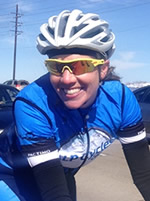by Jennifer Sharp, ALP Cycles Coaching
While each person responds differently to warm weather (some drive, others wilt) there are a few things you can do to beat the temps and ensure you have a good performance.
When should I ride? Keep in mind the time of day it’s the hottest. In Colorado, that means from 11am – 6pm is HOT. We highly recommend getting up early (at daybreak, if possible) and getting in those big miles early before the heat of the day.
What should I drink? While water is the obvious choice, athletes also benefit from a sports drink of some sort. As you exercise, you lose water  and electrolytes through sweat. Hydrating before you head out on a ride is one way to combat this loss of valuable fluids. I’ve personally had great success by drinking a preload hydration mix (that has an increased amount of sodium) 60 minutes before an intense effort like a crib or short track race, or even a long, intense training ride followed by a bottle of cold water.
and electrolytes through sweat. Hydrating before you head out on a ride is one way to combat this loss of valuable fluids. I’ve personally had great success by drinking a preload hydration mix (that has an increased amount of sodium) 60 minutes before an intense effort like a crib or short track race, or even a long, intense training ride followed by a bottle of cold water.
How do I stay cool? Two words: ice socks. Yes, it might seem a little weird when you buy a box of knee high many hose at your local pharmacy but filling it with several handfuls of ice and tying it up and putting it on your back between your shoulder blades will give you insane relief from the heat. Why panty hose? Because when the ice melts, you’ll have a small, discrete carry case that you can reuse.
How can I acclimate? If you really suffer in hot conditions, the best way to acclimate to them is to ride in them. Unfortunately there’s not an easy way around this. You can take it slow by starting your rides in the morning and working toward riding during the heat of the day. Start off exercising easy and slowly increase your intensity. Heat acclimation happens within 4-9 days of training and full acclimation occurs in about 14 days. Here’s a link to University of Connecticut’s Heat Acclimation recommendations.
When should I stop exercising? Cycling is earmarked with pain and suffering. We push our bodies to exhaustion and beyond normal warning signs. However, heat exhaustion and exertional heat stroke should not be taken lightly. If your body has a difficult time with heat and you feel like you may pass out – then stop. Using the tips above should help dealing with the heat.
ABOUT THE AUTHOR
 Jennifer Sharp, a USA Cycling Level 1 Coach, started racing in 2004 as a means to fulfill her competitive itch. Previously a national level boxer, she grew tired of getting hit in the head and decided to pound the pedals instead. She bought a pink Kona road bike completing several recreational rides and found herself passing as many people as possible. Since then she has multiple podiums at elite track national championships, master track national championship titles and world cup finishes under her belt.
Jennifer Sharp, a USA Cycling Level 1 Coach, started racing in 2004 as a means to fulfill her competitive itch. Previously a national level boxer, she grew tired of getting hit in the head and decided to pound the pedals instead. She bought a pink Kona road bike completing several recreational rides and found herself passing as many people as possible. Since then she has multiple podiums at elite track national championships, master track national championship titles and world cup finishes under her belt.
Jennifer, a Seattle native, joins the ALP Cycles Coaching with a background in road and track. Her experience as a USA ParaCycling team tandem pilot, part-time work at USA Cycling in the Coaching Education Department and love for all things cycling is a welcomed addition to the ALP Cycles Coaching team.
About ALP Cycles Coaching
ALP Cycles Coaching is located in the mountains of Colorado, and is a cycling coaching company with over 25 years of professional sports experience. ALP Cycles Coaching is unique in that we have 4 coaches, Alison Powers, Jennifer Triplett, and Patricia Schwager who each brings her own coaching strengths and personal experiences. We work together to create a training plan that works for each and every person. Visit them online at https://indyfreelance.com/

















